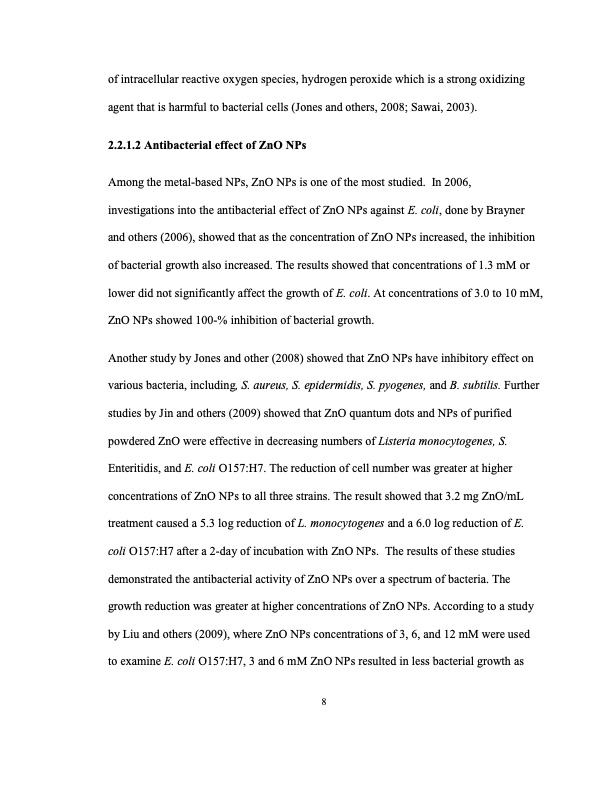
PDF Publication Title:
Text from PDF Page: 019
of intracellular reactive oxygen species, hydrogen peroxide which is a strong oxidizing agent that is harmful to bacterial cells (Jones and others, 2008; Sawai, 2003). 2.2.1.2 Antibacterial effect of ZnO NPs Among the metal-based NPs, ZnO NPs is one of the most studied. In 2006, investigations into the antibacterial effect of ZnO NPs against E. coli, done by Brayner and others (2006), showed that as the concentration of ZnO NPs increased, the inhibition of bacterial growth also increased. The results showed that concentrations of 1.3 mM or lower did not significantly affect the growth of E. coli. At concentrations of 3.0 to 10 mM, ZnO NPs showed 100-% inhibition of bacterial growth. Another study by Jones and other (2008) showed that ZnO NPs have inhibitory effect on various bacteria, including, S. aureus, S. epidermidis, S. pyogenes, and B. subtilis. Further studies by Jin and others (2009) showed that ZnO quantum dots and NPs of purified powdered ZnO were effective in decreasing numbers of Listeria monocytogenes, S. Enteritidis, and E. coli O157:H7. The reduction of cell number was greater at higher concentrations of ZnO NPs to all three strains. The result showed that 3.2 mg ZnO/mL treatment caused a 5.3 log reduction of L. monocytogenes and a 6.0 log reduction of E. coli O157:H7 after a 2-day of incubation with ZnO NPs. The results of these studies demonstrated the antibacterial activity of ZnO NPs over a spectrum of bacteria. The growth reduction was greater at higher concentrations of ZnO NPs. According to a study by Liu and others (2009), where ZnO NPs concentrations of 3, 6, and 12 mM were used to examine E. coli O157:H7, 3 and 6 mM ZnO NPs resulted in less bacterial growth as 8PDF Image | ZINC OXIDE AND SILVER NANOPARTICLES ON INTESTINAL BACTERIA

PDF Search Title:
ZINC OXIDE AND SILVER NANOPARTICLES ON INTESTINAL BACTERIAOriginal File Name Searched:
thesis-zinc-oxide-silver-nano.pdfDIY PDF Search: Google It | Yahoo | Bing
Turbine and System Plans CAD CAM: Special for this month, any plans are $10,000 for complete Cad/Cam blueprints. License is for one build. Try before you buy a production license. More Info
Waste Heat Power Technology: Organic Rankine Cycle uses waste heat to make electricity, shaft horsepower and cooling. More Info
All Turbine and System Products: Infinity Turbine ORD systems, turbine generator sets, build plans and more to use your waste heat from 30C to 100C. More Info
CO2 Phase Change Demonstrator: CO2 goes supercritical at 30 C. This is a experimental platform which you can use to demonstrate phase change with low heat. Includes integration area for small CO2 turbine, static generator, and more. This can also be used for a GTL Gas to Liquids experimental platform. More Info
Introducing the Infinity Turbine Products Infinity Turbine develops and builds systems for making power from waste heat. It also is working on innovative strategies for storing, making, and deploying energy. More Info
Need Strategy? Use our Consulting and analyst services Infinity Turbine LLC is pleased to announce its consulting and analyst services. We have worked in the renewable energy industry as a researcher, developing sales and markets, along with may inventions and innovations. More Info
Made in USA with Global Energy Millennial Web Engine These pages were made with the Global Energy Web PDF Engine using Filemaker (Claris) software.
Infinity Turbine Developing Spinning Disc Reactor SDR or Spinning Disc Reactors reduce processing time for liquid production of Silver Nanoparticles.
| CONTACT TEL: 608-238-6001 Email: greg@infinityturbine.com | RSS | AMP |